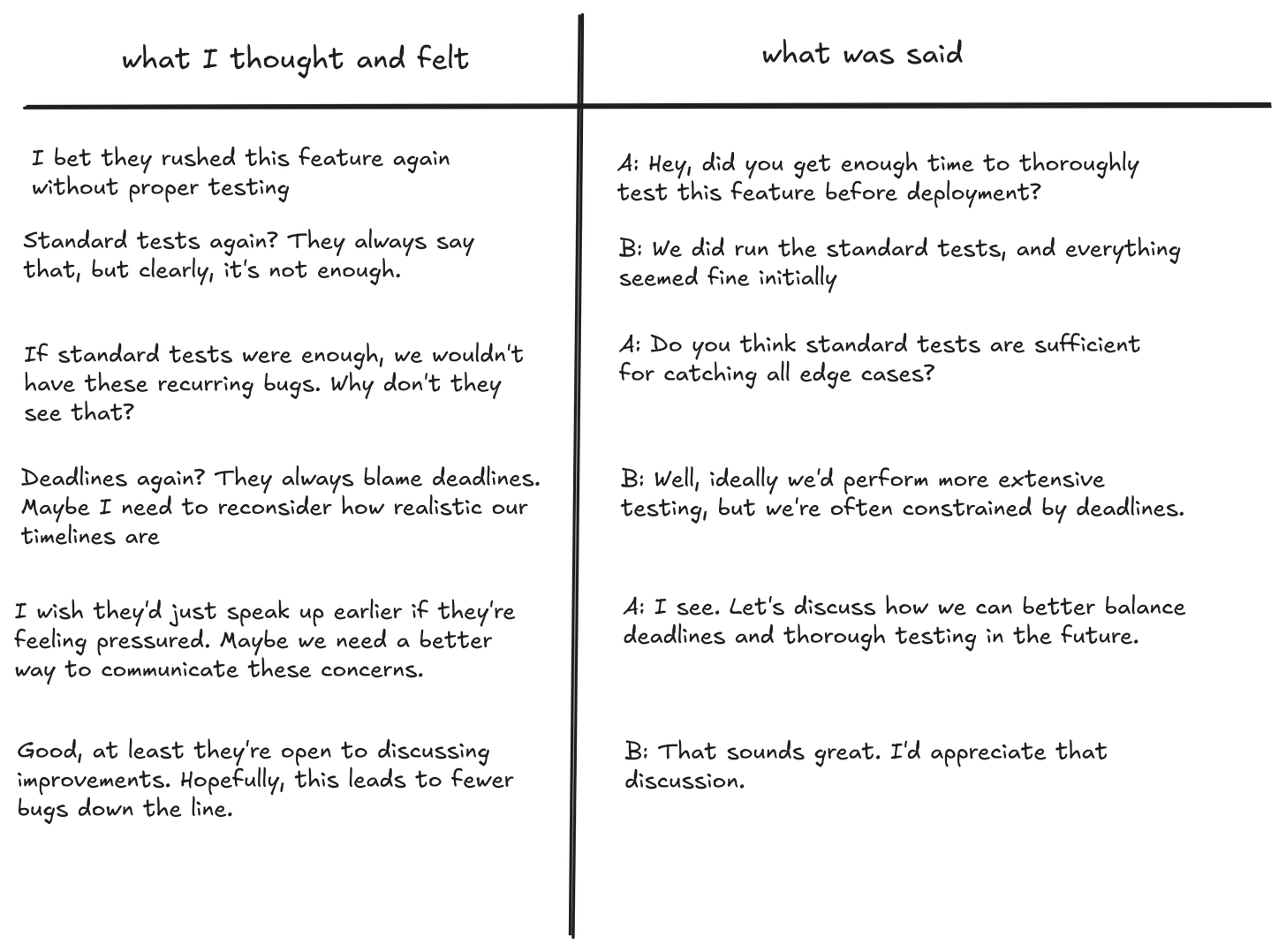the left/right column tool: bridging the gap between what we say and what we think
coz naming is hard
Last time, I introduced a way to analyse the decision process through the Ladder of Inference, a method developed by organisational psychologist Chris Argyris and later popularised by others like Peter Senge. Today, I would like to introduce you to another tool created by the same person: the left/right column.
Designed to highlight the gap between what we say and what we think during conversations, this simple yet powerful technique reveals the hidden assumptions and thought patterns that shape our communication outcomes.
Core Concept and Structure
The Left/Right Column tool reveals the two parallel conversations that occur during any interaction: the public dialogue and the private thoughts and the discrepancy between them.
The technique involves dividing a page into two columns:
Right-Hand Column: Contains the actual verbatim exchange. What was literally said by all parties in the conversation
Left-Hand Column: Records what you were thinking but not saying. Your unspoken thoughts, feelings, assumptions, and judgments
For instance:
Right Column (what’s said): “That’s an interesting idea.”
Left Column (what’s thought): “I don’t agree at all, but I don’t want to argue.”
This simple structure allows individuals to examine the discrepancy between their spoken words and internal dialogue, offering insights into communication patterns and potential barriers to effective interaction. It also allows us to distance ourselves from the conversation—having it written down on paper or computer allows emotional separation that is not available when we do this in our heads or through conversation.
How to Use the Tool
Here’s how you can get started:
Select a problematic or challenging conversation that didn't go as planned; it's good to reduce it to the problematic part, not to include the whole dialogue as it might be too long. A maximum of two A4 pages, but it would be good to fit it into one.
Draw a vertical line down a sheet of paper, creating two columns
In the right column, reconstruct the actual dialogue as accurately as possible (do not add assumptions, thoughts and feelings; record what was said)
In the left column, record what you were thinking but not saying at each point in the conversation
Being honest with yourself is key. This tool isn’t about self-criticism but about noticing your thoughts and exploring new options for future conversations.
Below you can find an example of the conversation between Manager (A) and Developer (B), with the thoughts and feelings of the Manager on the left side:
Once you have them written, you can reflect on the difference between the two columns to gain insights.
Applications and Benefits
The Left/Right Column tool has numerous practical applications:
Self-Reflection and Communication Improvement
The tool helps individuals understand their thought processes and communication patterns, particularly in difficult situations. By examining your left-hand column thoughts, you can:
Identify assumptions you're making about others
Recognize emotional reactions that influence your responses
Understand what prevented you from expressing certain thoughts
Evaluate whether your communication achieved the intended outcomes
Professional Applications
In professional settings, the tool helps:
Prepare for difficult meetings
Improve team communication and decision-making
Handle sensitive issues such as staff redeployment or change management
Support leadership development by enhancing self-awareness
Personal Relationship Enhancement
Beyond professional contexts, the tool benefits personal relationships by:
Facilitating better understanding between family members
Supporting parenting through improved communication with children
Resolving interpersonal conflicts more effectively
Integrating emotional and rational responses in conversations
Conclusion
The Left/Right Column tool provides a structured approach to understanding the often significant gap between our spoken words and internal thoughts. By making this gap visible, we can develop more authentic and effective communication strategies, leading to better outcomes in both professional and personal contexts. With practice, as Peter Senge notes, we can eventually learn to mentally fill in the left-hand columns in real-time, significantly enhancing our communication capabilities.
In the next post, we will build on top of that tool, extending it and providing a framework you can work with daily.
Ready to try it for yourself?
Why not give the Left/Right Column tool a try with your following challenging conversation? Take just a few minutes to separate what was said from what you were really thinking - you may be surprised by the insights you uncover. As you build awareness of these gaps, you’ll find yourself communicating more authentically and effectively at work and home. If you try this exercise, I’d love to hear about your experience - feel free to share your observations or questions in the comments below!



